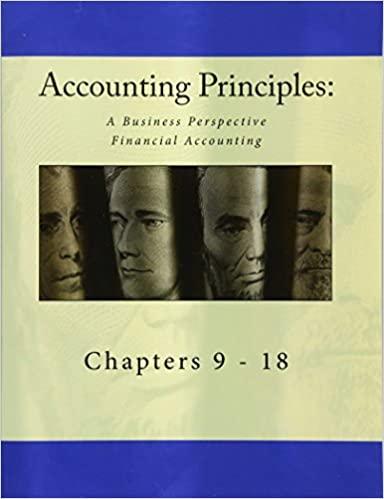Question
Multiple choice questions. No need to explain. Question 1: Ace Co. prepared an aging of its accounts receivable at December 31, 2010 and determined that
Multiple choice questions. No need to explain.
Question 1:
Ace Co. prepared an aging of its accounts receivable at December 31, 2010 and determined that the net realizable value of the receivables was $300,000. Additional information is available as follows:
| Allowance for uncollectible accounts at 1/1/10credit balance | $ 34,000 |
| Accounts written off as uncollectible during 2010 | 23,000 |
| Accounts receivable at 12/31/10 | 325,000 |
| Uncollectible accounts recovered during 2010 | 5,000 |
For the year ended December 31, 2010, Ace's uncollectible accounts expense would be
| $25,000. |
| $23,000. |
| $16,000. |
| $9,000. |
Question 2
An accountant wishes to find the present value of an annuity of $1 payable at the beginning of each period at 10% for eight periods. The accountant has only one present value table which shows the present value of an annuity of $1 payable at the end of each period. To compute the present value, the accountant would use the present value factor in the 10% column for
| seven periods. |
| eight periods and multiply by (1 + .10). |
| eight periods. |
| nine periods and multiply by (1 .10). |
Question 3
An accrued revenue can best be described as an amount
| collected and currently matched with expenses. |
| collected and not currently matched with expenses. |
| not collected and currently matched with expenses. |
| not collected and not currently matched with expenses. |
Question 4
An effective capital allocation process
| promotes productivity. |
| encourages innovation. |
| provides an efficient market for buying and selling securities. |
| all of these. |
Question 5
During the lifetime of an entity, accountants produce financial statements at arbitrary points in time in accordance with which basic accounting concept?
| Cost/benefit constraint |
| Periodicity assumption |
| Conservatism constraint |
| Matching principle |
Question 6
Equestrain Roads accepted a customer's $50,000 zero-interest-bearing six-month note payable in a sales transaction. The product sold normally sells for $46,000. If the sale was made on June 30, how much interest revenue from this transaction would be recorded for the year ending December 31?
| $0. |
| $2,000. |
| $4,000. |
| $5,000. |
Flag this Question
Question 71 pts
FASB Technical Bulletins
| are similar to FASB Interpretations in that they establish enforceable standards under the AICPA's Code of Professional Ethics. |
| are issued monthly by the FASB to deal with current topics. |
| are not expected to have a significant impact on financial reporting in general and provide guidance when it does not conflict with any broad fundamental accounting principle. |
| were recently discontinued by the FASB because they dealt with specialized topics having little impact on financial reporting in general. |
Flag this Question
Question 81 pts
Financial statements in the early 2000s provide information related to
| nonfinancial measurements. |
| forward-looking data. |
| hard assets (inventory and plant assets). |
| none of these. |
Question 9
Free cash flow is calculated as net cash provided by operating activities less
| capital expenditures. |
| dividends. |
| capital expenditures and dividends. |
| capital expenditures and depreciation. |
Question 10
Fulton Company owns the following investments:
| Trading securities (fair value) | $60,000 |
| Available-for-sale securities (fair value) | 35,000 |
| Held-to-maturity securities (amortized cost) | 47,000 |
Fulton will report investments in its current assets section of
| $0. |
| exactly $60,000. |
| $60,000 or an amount greater than $60,000, depending on the circumstances. |
| exactly $95,000. |
Step by Step Solution
There are 3 Steps involved in it
Step: 1

Get Instant Access to Expert-Tailored Solutions
See step-by-step solutions with expert insights and AI powered tools for academic success
Step: 2

Step: 3

Ace Your Homework with AI
Get the answers you need in no time with our AI-driven, step-by-step assistance
Get Started


